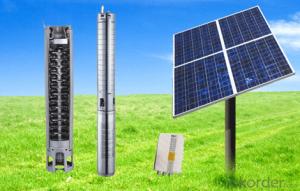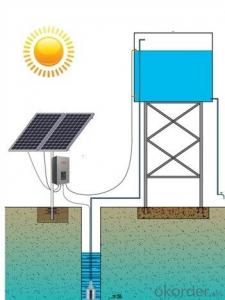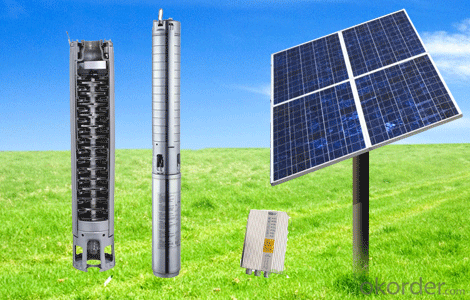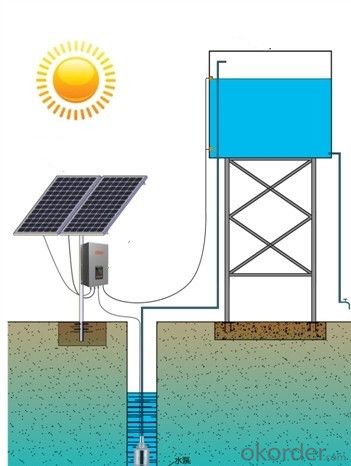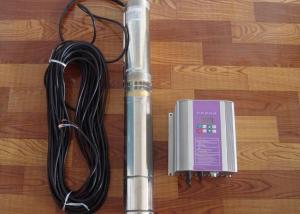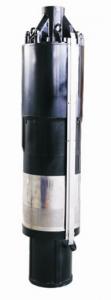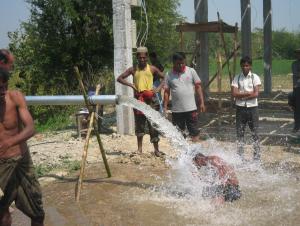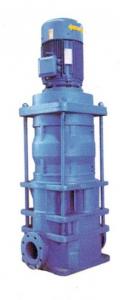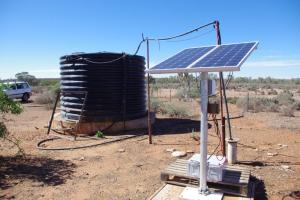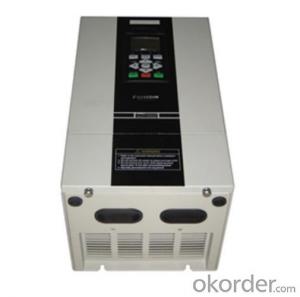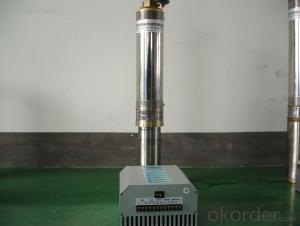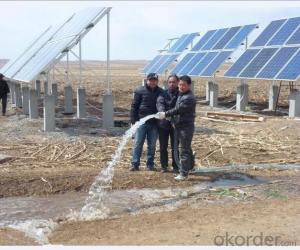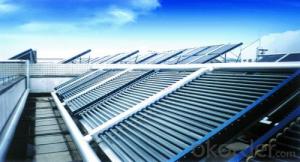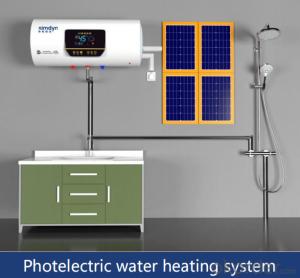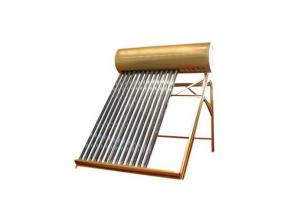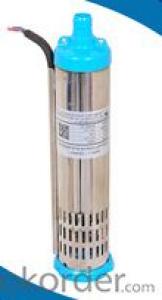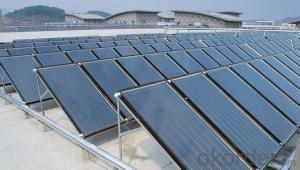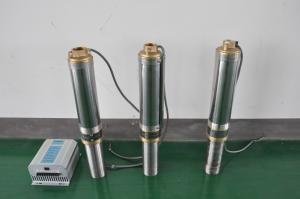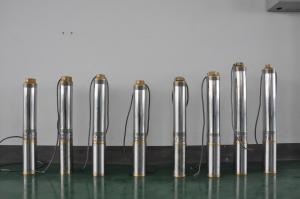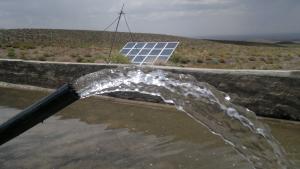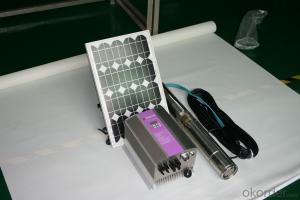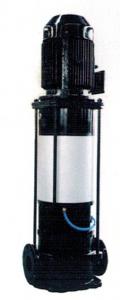Solar Pump Factory Homemade Solar Water Heater
- Loading Port:
- Shanghai
- Payment Terms:
- TT OR LC
- Min Order Qty:
- 1 set
- Supply Capability:
- 1000 set/month
OKorder Service Pledge
OKorder Financial Service
You Might Also Like
Solar Pump Price Homemade Solar Water Heater
DC solar water pumping system consists of the motor, pump, controller, solar array and some other accessories, such as water level sensor, float switch, etc. Considered that storing water is more efficient than storing electricity, the system is designed to directly drive the pump without battery which can reduce the construction and operating cost and routine maintenance effectively.The PV array consists of multiple solar panels connected in series/parallel, which can supply the whole system as power source by converting the absorbed solar radiation energy to the electrical energy. The pump driven by a brushless DC permanent magnet motor draws water from deep-well or river. The pumped water is then fed into reservoir or water tank, or connected to the irrigation system or fountain system directly.
Advanced Technology
Applications Innovation
The efficiency of DC brushless permanent magnet motor has been increased up to 25% in comparison with traditional asynchronous motor.
Technology Innovation
Stator and rotor are sealed by environment friendly casting resin.Motor insulation resistance can be hold higher than 300MΩfor more than 10 years, which consumedly increased the security and reliability of the submersible motor.
Structure Innovation
Casting resign technology processed stator and rotor as well as the water lubricated bearing make the submersible pump environment friendly.
Feature
High Efficiency & High Reliability
DC Brushless Permanent Magnet Motor
Minimum Maintenance, long Service Life
Environment Friendly Materials, Lubricated Without Oil
Application
Village or Family Water Supply
Animal Drinking Water & Livestock Watering
Garden/Courtyard Irrigation
Swimming Pool
Water Supply for Bivouac or Camping Car
Water Supply for Remote Area
Automatic Control
Operate Automatically, No Need Watching
Maximum Power Point Tracking (MPPT)
Dry-run Protection
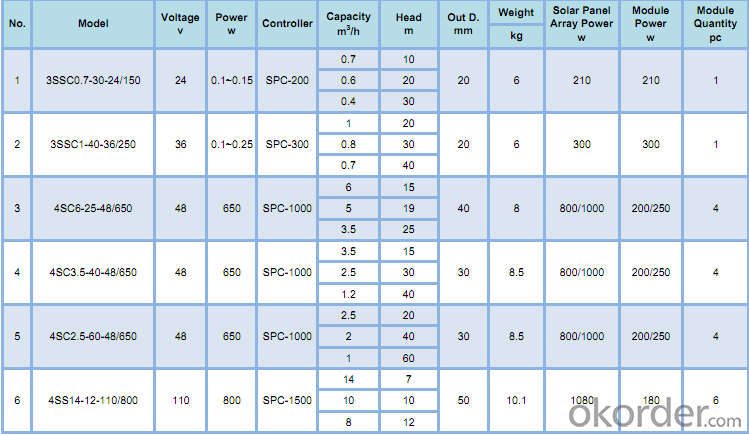
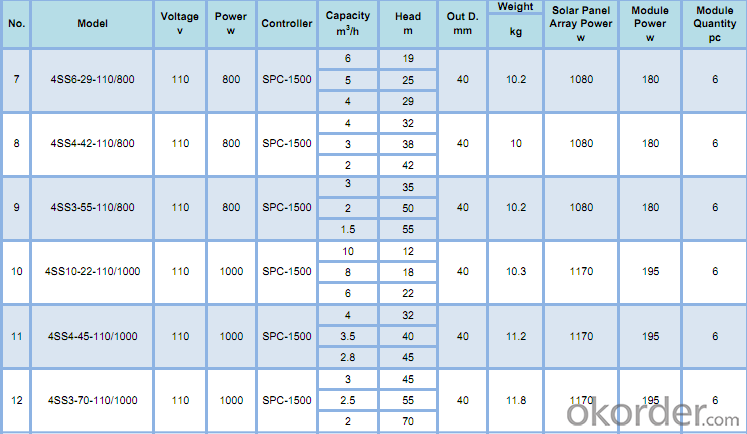
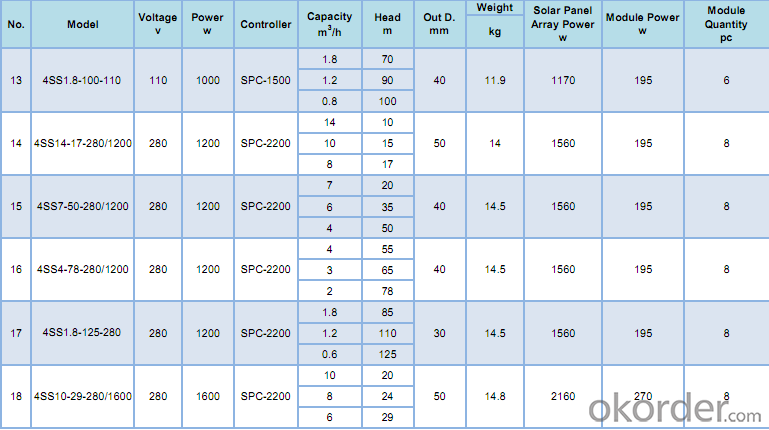
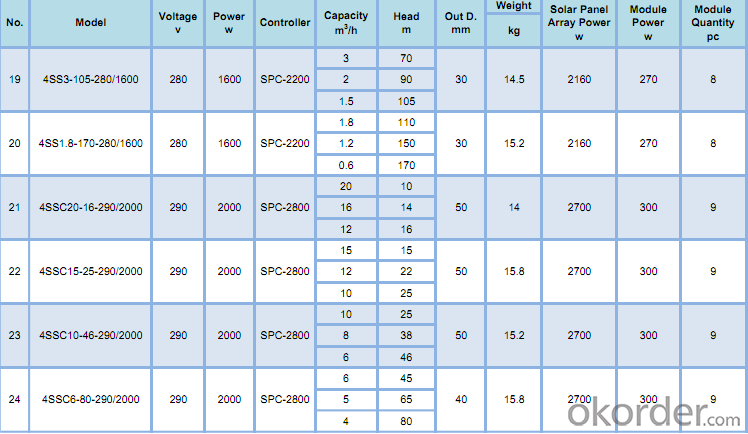
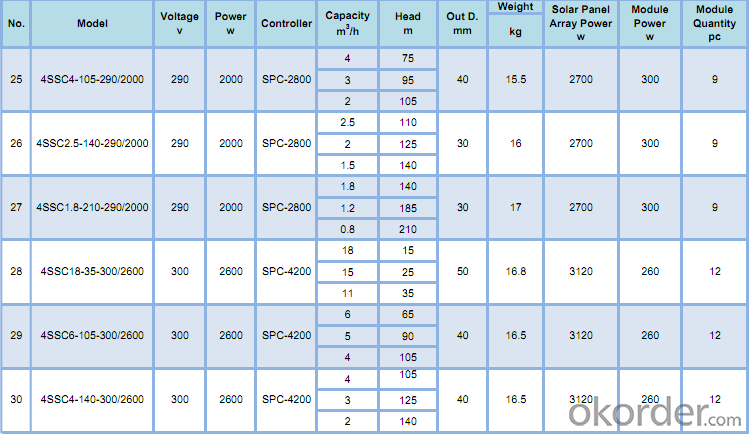
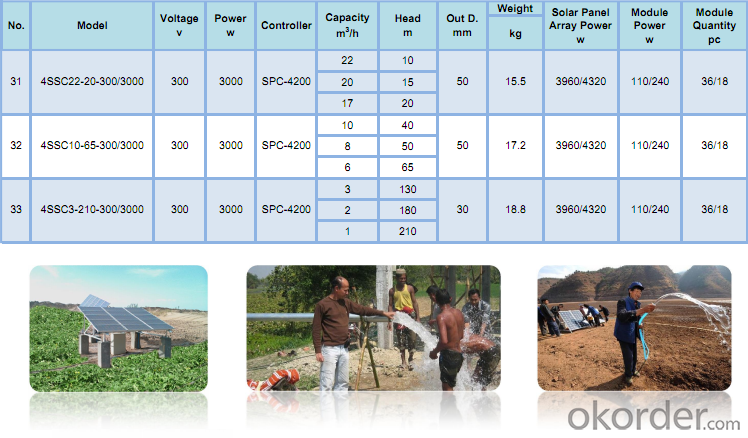
- Q: What type of maintenance is required for a solar pump?
- Regular maintenance is required for a solar pump, which typically includes cleaning the solar panels to ensure maximum efficiency, inspecting and replacing any worn or damaged parts, checking the connections and wiring for any loose or faulty connections, and monitoring the overall performance of the pump to address any issues promptly.
- Q: How does a solar pump handle water with high levels of sand or other abrasives?
- A solar pump with high levels of sand or other abrasives in the water may face challenges in terms of clogging and reduced efficiency. However, some solar pumps are designed with features like built-in filters or screens to prevent sand and other particles from entering the pump. Additionally, regular maintenance and cleaning of the pump can help mitigate the impact of high levels of sand or abrasives on its performance.
- Q: Can a solar pump be used for water supply in a farm?
- Yes, a solar pump can be used for water supply in a farm. Solar pumps are designed to harness energy from the sun and convert it into mechanical power to pump water. They are an environmentally friendly and cost-effective solution for farms, as they can provide a continuous and reliable water supply without relying on grid electricity or fuel. The use of solar pumps for water supply in farms can help reduce operational costs and promote sustainable agriculture practices.
- Q: How does the cost of a solar pump compare to a traditional electric pump?
- The cost of a solar pump compared to a traditional electric pump can vary depending on several factors. Initially, the upfront cost of a solar pump is typically higher than that of a traditional electric pump. Solar pumps require additional components such as solar panels, inverters, and batteries, which contribute to their higher initial cost. However, it is important to consider the long-term savings and benefits of a solar pump. Solar pumps operate using renewable energy from the sun, eliminating the need for electricity from the grid, which can result in significant savings on electricity bills. Additionally, solar pumps have lower maintenance costs compared to electric pumps since they have fewer moving parts, reducing the need for regular repairs and replacements. The cost of electricity is also a crucial factor to consider. In areas with high electricity costs, the savings generated by a solar pump over time can offset the initial investment. Furthermore, solar pumps can be more cost-effective in remote or off-grid locations where extending electrical lines can be expensive and impractical. Government incentives and subsidies can also affect the cost comparison. Many countries and regions offer financial incentives, grants, or tax credits for adopting solar technology, which can offset the initial cost and make solar pumps more economical in the long run. In summary, while the upfront cost of a solar pump may be higher than a traditional electric pump, the long-term savings on electricity bills, lower maintenance costs, and potential government incentives can make solar pumps a more cost-effective and environmentally friendly option.
- Q: How does the cost of maintenance for a solar pump system compare to a traditional electric pump?
- Compared to traditional electric pumps, solar pump systems generally have lower maintenance costs. This is because solar pump systems primarily rely on renewable energy, eliminating the need for electricity from the grid and reducing operating expenses. On the other hand, traditional electric pumps require a constant supply of electricity, which can be expensive, especially in areas with high electricity rates. In addition, solar pump systems have fewer moving parts, making them less susceptible to mechanical failures. This results in lower maintenance and repair expenses. Furthermore, solar pumps do not require fuel or lubrication, further reducing maintenance costs. Moreover, solar pump systems have longer lifespans than traditional electric pumps. While electric pumps typically last around 10-15 years, solar pumps can last up to 25 years or more when properly maintained. This prolonged lifespan reduces the need for frequent replacements and the associated costs. To summarize, the maintenance cost of a solar pump system is generally lower compared to that of a traditional electric pump. The reduced reliance on grid electricity, fewer moving parts, and longer lifespan all contribute to the overall cost-effectiveness of solar pump systems in terms of maintenance.
- Q: Are there any limitations to the flow rate of a solar pump?
- Yes, there are limitations to the flow rate of a solar pump. The flow rate of a solar pump depends on various factors such as the size and capacity of the pump, the power output of the solar panels, the intensity of sunlight, and the depth of the water source. If the pump is not properly sized or the solar panels do not generate enough power, it may result in a lower flow rate. Additionally, if the water source is deep, the pump may need to work against higher pressures, which can also limit the flow rate. It is important to consider these limitations and properly size and design the solar pump system to ensure optimal flow rates for the intended application.
- Q: How does the maintenance cost of a solar pump system compare to a traditional electric pump?
- Compared to traditional electric pumps, solar pump systems generally have lower maintenance costs. This is because solar pumps have fewer moving parts and no complex electrical systems, reducing the risk of mechanical failure and the need for extensive maintenance. Solar pumps operate using solar panels, which have a long lifespan and require minimal upkeep. The primary maintenance tasks for a solar pump system involve regularly checking and cleaning the solar panels to ensure optimal performance. Additionally, occasional maintenance may be required for the pump itself, such as lubrication and inspection of connections. On the contrary, traditional electric pumps require more frequent maintenance due to the complexity of their electrical systems and moving parts. These pumps often have motors, wiring, and other components that can wear out over time, necessitating maintenance or replacement. The electrical connections also need to be regularly inspected and maintained to prevent potential issues. Furthermore, traditional electric pumps are typically connected to the grid, making them susceptible to fluctuations in electricity prices. This can result in higher operational costs compared to solar pumps, which rely on the sun's energy and do not incur ongoing electricity expenses. Overall, although both solar pump systems and traditional electric pumps require maintenance, the maintenance cost of a solar pump system tends to be lower due to its simpler design, fewer moving parts, and reduced reliance on external power sources.
- Q: Are there different types of solar pumps available?
- Yes, there are various types of solar pumps available, including submersible solar pumps, surface solar pumps, and solar-powered irrigation systems. Each type is designed for specific applications and offers different features and benefits.
- Q: Can a solar pump be used for water supply in off-grid poultry farms?
- Yes, a solar pump can be used for water supply in off-grid poultry farms. Solar pumps are an excellent option for off-grid applications as they rely on solar energy to power the pump. These pumps utilize photovoltaic panels to convert sunlight into electricity, which is then used to run the pump and supply water. Using a solar pump for water supply in off-grid poultry farms offers several advantages. Firstly, it eliminates the need for grid electricity, reducing operating costs and making it a more sustainable and environmentally friendly option. Solar pumps are also easy to install and require minimal maintenance, making them suitable for remote locations such as off-grid poultry farms. Additionally, solar pumps can be used to supply water for various purposes in a poultry farm, including providing drinking water for the chickens, filling up water troughs, and facilitating the irrigation of crops or gardens on the farm. This ensures a consistent and reliable water supply for the poultry and helps maintain optimal conditions for their growth and well-being. Overall, utilizing a solar pump for water supply in off-grid poultry farms is a viable and efficient solution that offers numerous benefits, including cost savings, sustainability, and reliable water availability.
- Q: Can a solar pump be used for wastewater treatment?
- Yes, a solar pump can be used for wastewater treatment. Solar pumps can be effectively utilized in wastewater treatment systems to circulate and aerate the water, facilitating the breakdown of pollutants and promoting the growth of beneficial bacteria. This renewable energy solution can help reduce electricity costs and environmental impact, making it a sustainable choice for wastewater treatment processes.
Send your message to us
Solar Pump Factory Homemade Solar Water Heater
- Loading Port:
- Shanghai
- Payment Terms:
- TT OR LC
- Min Order Qty:
- 1 set
- Supply Capability:
- 1000 set/month
OKorder Service Pledge
OKorder Financial Service
Similar products
Hot products
Hot Searches
Related keywords
